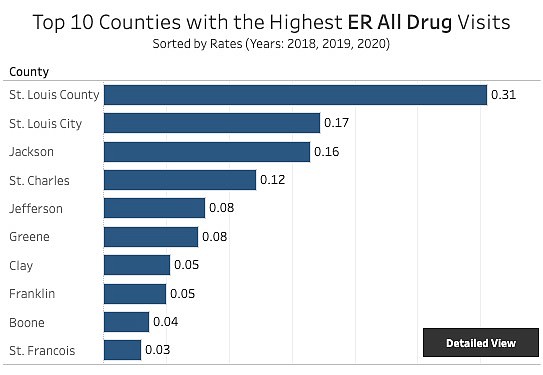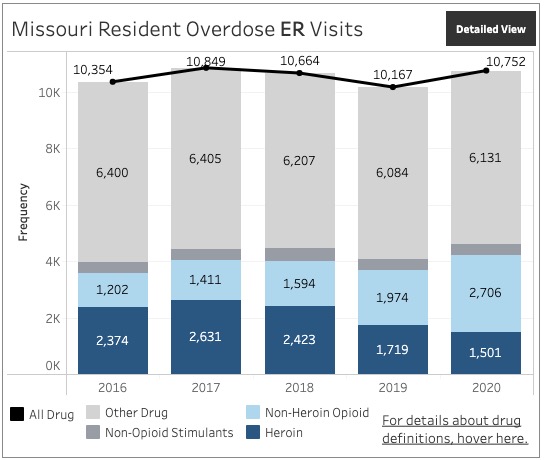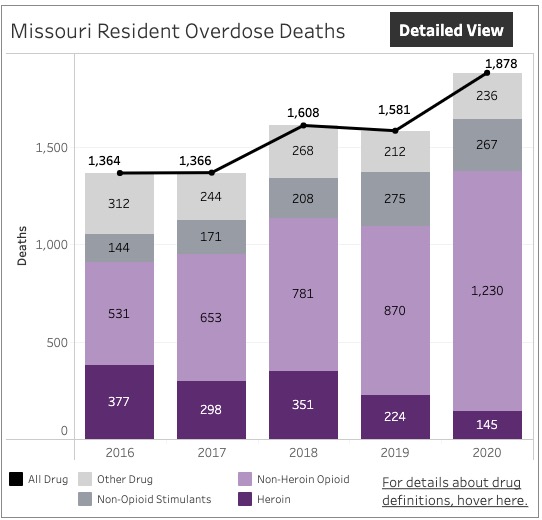Sixteen overdose deaths in both Cole and Callaway counties over the past three years put the counties near the top in Central Missouri in terms of volume of such deaths.
Only Boone (67 deaths), Pulaski (56 deaths) and Phelps (41 deaths) counties had more, according to data provided Tuesday by the Missouri Department of Health and Senior Services (DHSS). The News Tribune generally doesn't study data for the latter two counties because they fall outside readership area.
But other local counties had much higher rates per 100,000 population than Cole County (6.96 per 100,000). Boone County (12.33 per 100,000 population), Callaway County (11.89), Camden County (10.83), Gasconade County (29.56), Maries County (30.46), Morgan County (8.10), Phelps County (30.66) and Pulaski County (35.59) reported higher rates.
DHSS launched a drug overdose dashboard Tuesday, showing data regarding fatal and nonfatal overdoses, where they occurred (by county) and demographic makeup of those who overdosed.
Data reflect incidents through 2020.
"With 1,878 deaths, 2020 had the highest number of fatal drug overdoses to date in the state of Missouri -- a 19 percent increase from 2019," a DHSS news release points out. "(And) 1,375 of these deaths involved opioids."
The increase in Missouri follows national trends, according to the release.
Drug overdose remains the leading cause of deaths in adults ages 18-44, according to the release. Missouri in 2020 ranked 32nd among all states and the District of Columbia for drug overdose death rates. More than 70 percent of all drug overdose deaths in Missouri involved opioids -- heroin, fentanyl, methadone, morphine, oxycodone, and other prescription and non-prescription pain relievers.
"The opioid crisis is an issue only made worse by the COVID-19 pandemic," Paula Nickelson, acting DHSS director, said in the release. "This is a health crisis that knows no bounds -- it affects all genders, races and ages in both rural and urban communities."
The state's efforts to combat opioid misuse and overdoses include monitoring and prevention strategies designed to improve data quality, inform decision-making and implement targeted interventions, the news release said.
Only last year, Missouri lawmakers passed the state's Prescription Drug Monitoring Program. It was supposed to go into effect Oct. 1.
Within that program, prescribers of controlled substances for participants of the Missouri Medicaid Program (MO HealthNet) must check an available prescription drug monitoring program prior to prescribing controlled substances. In case the prescriber is unable to check with an available monitoring program, the prescriber must document the good faith effort to do so, including why they were unable to perform the check. The prescriber must also maintain the documentation in the participant's record to be submitted to the state upon request.
The DHSS has implemented several other strategies to intervene in overdose deaths in Missouri.
It is monitoring data through:
• Collection and dissemination of timely emergency department data on all suspected drug, opioid, heroin and stimulant overdoses: Perform monitoring in Missouri's Electronic Surveillance System for the Early Notification of Community-based Epidemics (ESSENCE) using case definitions for all drugs, opioids, heroin and stimulant overdoses.
• Collection and dissemination of descriptions of drug overdose death circumstances using death certificates and medical examiner/coroner data: Collecting data from death certificates and medical examiner/coroner reports and enter data into the State Unintentional Drug Overdose Reporting System (SUDORS).
• Implementation of innovative surveillance: Linking records between two nonfatal data sources, ESSENCE and Patient Abstract System (comprehensive systems which collect information on inpatient and observation patient community hospital stays), on various overdose types to evaluate the relationship between overdoses reported with more real time data versus more comprehensive but lagged data.
DHSS is implementing prevention methods -- conducting regulatory inspections on high-risk prescribers and outliers, looking for regulatory actions and remedies, and providing information to prescribers about prescribing guidelines. It has also established 16 contracts with select local public health agencies to focus on opioid and illicit drug use prevention and response efforts.
DHSS has established a linkage of opioid overdose mortality data with offenders released from the Missouri Department of Corrections. It also has a linkage with the High Intensity Drug Trafficking Area to review drug seizure data and compare with opioid overdose mortality data.
DHSS will launch a new media campaign based on the most recent data to raise awareness of opioid misuse and overdose. DHSS has previously implemented three separate campaigns to focus on opioid awareness and harm-reduction strategies. The campaign targeted zip codes with the highest opioid mortality rates. Campaigns have been released on radio, billboards, at gas stations, across social media platforms and through other venues and platforms, according to the release.
The dashboard provides some details about nonfatal emergency room visits (per county or City of St. Louis) concerning drug overdoses.
St. Louis County, with 5,620 emergency room visits during 2018, 2019 and 2020, led the state. It was followed by St. Louis City (3,177) and Jackson County (3,033). Boone County was ninth highest (674). Cole County was 14th (363).



